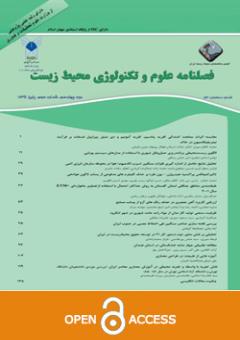Climatic analysis and satellite assessment of the drought situation in Dahuk Province, Kurdistan Region of Iraq
Subject Areas : environmental managementJabbar Haji Sarkaft 1 , Sohaila Javanmard 2 , Zahra Azizi 3 , Majid Habibi Nokhandan 4
1 - Master student, Department of Remote Sensing and Geographical Information System, Faculty of Natural Resources and Environment, Azad University, Science and Research Unit, Tehran, Iran.
2 - Associated professor, Research Institute of Meteorology and Atmospheric Sciences, Tehran, Iran. *(Corresponding Author)
3 - Assistant professor, Department of Remote Sensing and Geographical Information System, Faculty of Natural Resources and Environment, Azad University, Science and Research Unit, Tehran, Iran.
4 - Associated professor, Research Institute of Meteorology and Atmospheric Sciences, Tehran, Iran.
Keywords: drought, SPI index, NDVI vegetation index, Kurdistan climate, MODIS sensor.,
Abstract :
Background and Objective: Investigating regional climatic and natural characteristics is one of the most important issues in environmental research. Studying natural and climatic features and knowing them is necessary for planning.
Material and Methodology: First, climatic components, including monthly and annual average rainfall and temperature of weather stations of Dahuk province (Dahuk, Akri and Amidi) were extracted during 6 years (2015-2020). Then, three meteorological stations of Dahuk province were determined by using meteorological parameters of Blair and Dumarten climate classification. Also, in order to evaluate the drought, the standardized rainfall index (SPI) and the normalized NDVI vegetation difference index have been used during the years in question.
Findings: According to Blair's climate classification, all three cities of Dahuk, Akri and Amidi are considered semi-humid areas. Also, based on Dumarten's climate classification, Dahuk city is classified as semi-arid and Akri and Amidi cities are classified as semi-humid regions. According to the SPI index, it was found that the driest month happened in June 2017 with SPI -1.67 (very dry) and the wettest month in March 2019 with SPI 3.48(extremely wet). Using the NDVI index, the vegetation percentage of Dahuk province was also extracted during 6 years (2015-2020). After this year of drought, the two years of 2018 and 2019, the index faced an upward trend and reached the wet and very wet level. NDVI vegetation percentage of Dahuk station was investigated during 6 years. The average vegetation cover has been higher than the other grades in all years. Since 2017, the average vegetation cover has decreased compared to other years. Weak vegetation has increased from 2015 to 2017. Since 2017, this value has decreased until 2020.
Discussion and Conclusion: Discussion and conclusion: SPI index values show that in 2017 drought occurred in Dahuk province. So that the drought started in 2015, continued in 2016 and reached its peak in 2017. These values and trends were consistent with the percentage of vegetation in Dahuk city. The data related to Dahuk, Akri and Amidi meteorological stations on the table and graphs are consistent with the satellite data provided by the Landsat satellite
1. Zhao, M., & Running, S. W. (2010). Drought-induced reduction in global terrestrial net primary production from 2000 through 2009. Science, 329(5994), 940-943.
2. Vicente-Serrano, S. M., Beguería, S., & López-Moreno, J. I. (2010). A multiscale drought index sensitive to global warming: the standardized precipitation evapotranspiration index. Journal of climate, 23(7), 1696-1718.
3. Heim Jr, R. R. (2002). A review of twentieth-century drought indices used in the United States. Bulletin of the American Meteorological Society, 83(8), 1149-1166.
4. Prakasam, C., & Saravanan, R. (2022). Agricultural Drought Assessment Using GIS: A Case Study. In Hydrological Modeling (pp. 165-181). Springer, Cham.
5. Ji, L., & Peters, A. J. (2003). Assessing vegetation response to drought in the northern Great Plains using vegetation and drought indices. Remote Sensing of Environment, 87(1), 85-98.
6. Zhao, Y.; Zhang, J.; Bai, Y.; Zhang, S.; Yang, S.; Henchiri, M.; Seka, A.M.; Nanzad, L. (2022). Drought Monitoring and Performance Evaluation Based on Machine Learning Fusion of Multi-Source Remote Sensing Drought Factors. Remote Sens., 14, 6398. https://doi.org/3390/10/rs14246398
7. Jianzhu, L.; Shuhan, Z.; Ro’ng, (2015). H. Hydrological Drought Class Transition Using SPI and SRI Time Series by Log linear Regression. Water Resource. Manage. 30, 669–684.
8. Kim, S. W., Jung, D., & Choung, Y. J., (2020). Development of a multiple linear regression model for meteorological drought index estimation based on Landsat satellite imagery. Water, 12(12), 3393.
9. Mtilatila, L., Bronstert, A., Bürger G., Vormoor K., (2020). Meteorological and hydrological drought assessment in Lake Malawi and Shire River basins (1970–2013), Hydrological Sciences Journal, 65:16, 2750-2764, DOI: 1080/10/2020/02626667.1837384.
10. Salighe, M., F. Berimani, Smaeelnejad, M., (2017) Climatic Zoning of Sistan and Baluchistan Province, Journal of Geography and Development, No. 12. (In Persian)
11. Masoudian, Seyyed Abulfazl, Kaviani, Mohammad Reza. (2009). Climatology of Iran, Isfahan University Press, (In Persian)
12. McKee, T. B., J. Nolan, and J. Kleist, (1993). The relationship of drought frequency and duration to time scales. Preprints, Eighth Conf. on Applied Climatology, Anaheim, CA, Amer. Meteor, Soc., 179- 184.
13. Edwards D. C. and Mckee T. B. (1997), Characteristics of 20th century drought in the United States at multiple time scales, Colorado State University, Atmospheric Science Paper No. 634, Climatology Report No. 97-2.
14. Viana, C. M., Oliveira, S., Oliveira, S. C., & Rocha, J., (2019). Land use/land cover change detection and urban sprawl analysis. In Spatial modeling in GIS and R for earth and environmental sciences (pp. 621-651). Elsevier.
15. Drisya, J., & Roshni, T., (2018). Spatio-temporal variability of soil moisture and drought estimation using a distributed hydrological model. In Integrating disaster science and management (pp. 451-460). Elsevier.


